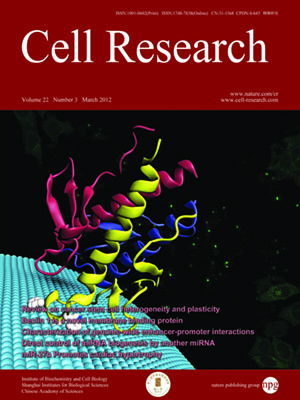
Volume 22, No 3, Mar 2012
ISSN: 1001-0602
EISSN: 1748-7838 2018
impact factor 17.848*
(Clarivate Analytics, 2019)
Volume 22 Issue 3, March 2012: 473-489
ORIGINAL ARTICLES
Crystal structure and biochemical analyses reveal Beclin 1 as a novel membrane binding protein
Weijiao Huang1,2,*, Wooyoung Choi1,2,*, Wanqiu Hu1,3, Na Mi1,3, Qiang Guo2, Meisheng Ma1,3, Mei Liu1,3, Yuan Tian1,3, Peilong Lu1,2, Feng-Liang Wang4, Haiteng Deng1, Lei Liu1,4, Ning Gao2, Li Yu1,3 and Yigong Shi1,2
1Tsinghua-Peking Joint Center for Life Sciences, Tsinghua University, Beijing 100084, China
2Center for Structural Biology, Tsinghua University, Beijing 100084, China
3State Key Laboratory of Bio-membrane and Membrane Biotechnology, School of Life Sciences and School of Medicine, Tsinghua University, Beijing 100084, China
4Department of Chemistry, Tsinghua University, Beijing 100084, China
Correspondence: Li Yu, Yigong Shi,(liyulab@tsinghua.edu.cn; shi-lab@tsinghua.edu.cn)
The Beclin 1 gene is a haplo-insufficient tumor suppressor and plays an essential role in autophagy. However, the molecular mechanism by which Beclin 1 functions remains largely unknown. Here we report the crystal structure of the evolutionarily conserved domain (ECD) of Beclin 1 at 1.6 Å resolution. Beclin 1 ECD exhibits a previously unreported fold, with three structural repeats arranged symmetrically around a central axis. Beclin 1 ECD defines a novel class of membrane-binding domain, with a strong preference for lipid membrane enriched with cardiolipin. The tip of a surface loop in Beclin 1 ECD, comprising three aromatic amino acids, acts as a hydrophobic finger to associate with lipid membrane, consequently resulting in the deformation of membrane and liposomes. Mutation of these aromatic residues rendered Beclin 1 unable to stably associate with lipid membrane in vitro and unable to fully rescue autophagy in Beclin 1-knockdown cells in vivo. These observations form an important framework for deciphering the biological functions of Beclin 1.
Cell Research (2012) 22:473-489. doi:10.1038/cr.2012.24; published online 7 February 2012
FULL TEXT | PDF
Browse 2304


